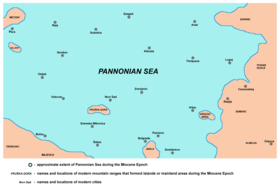Pannonian Sea


The Pannonian Sea was a shallow ancient sea located where the Pannonian Plain in Central Europe is now. The Pannonian Sea existed during the Miocene and Pliocene epochs, when a three to four kilometre depth of marine sediments were deposited in the Pannonian Basin.
History
The Pannonian Sea, for most of its history, was part of the Paratethys Sea. A Miocene uplift of the Carpathian Mountains isolated the sea from the rest of Paratethys (about 10 million years ago).
During its first historical phase, the Pannonian Sea had a western connection with the Mediterranean Sea through the territories of the modern Ligurian Sea, Bavaria, and Vienna Basin. Through the Đerdap Strait, the Pannonian Sea was linked to the Paratethys in the Wallachian-Pontic Basin. The Pannonian Sea was also attached to the Aegean Sea through the modern Preševo Valley.
Due to its diverse history the salinity of the sea often shifted. The decrease of salinity resulted an endemic fauna.
The Pannonian Sea existed for about 9 million years. Eventually, the sea lost its connection to the Paratethys and became a lake permanently (Pannonian Lake). Its last remnant, the Slavonian Lake, disappeared in the Pleistocene era. The remnants of the former islands of the Pannonian Sea are the modern Pannonian island mountains (Mecsek, Papuk, Psunj, Krndija, Dilj, Fruška Gora, and Vršac Mountains).
In popular culture
In 1979, the Serbian musician Đorđe Balašević released a single titled Panonski Mornar (Pannonian sailor).
See also
- Paratethys
- Pannonian Plain
- Pannonian Basin
- Piemont-Liguria Ocean
- Iron Gate (Danube)
References
- Dragan Rodić, Geografija za I ili III razred srednje škole, Zavod za udžbenike i nastavna sredstva, Beograd, 1995.
- Dr Dušan J. Popović, Srbi u Vojvodini, knjiga 1, Novi Sad, 1990.
- Dr Aleksa Ivić, Istorija Srba u Vojvodini, Novi Sad, 1929.
- Predrag Medović, Praistorija na tlu Vojvodine, Novi Sad, 2001.
External links
| Wikimedia Commons has media related to Pannonian Sea. |
- Map of the Pannonian Sea (in Hungarian)
- Map of the Pannonian Sea (in German)